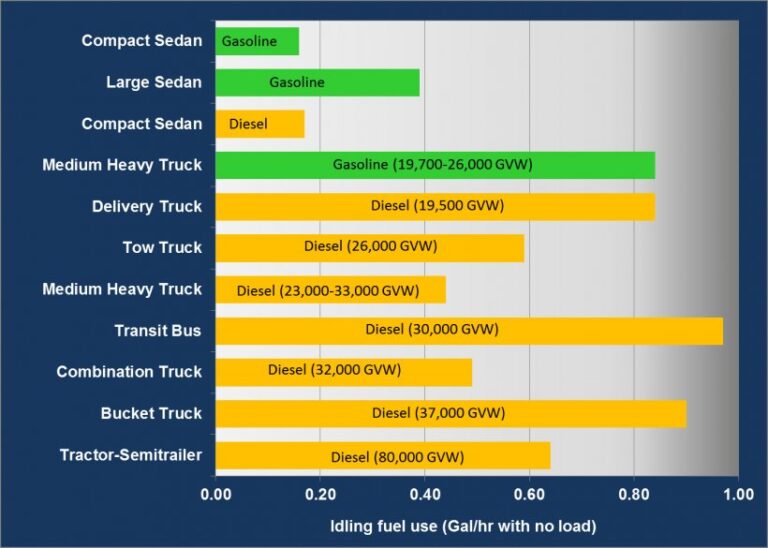
Idling a semi truck is generally not recommended as it can lead to unnecessary fuel consumption and air pollution. However, there are certain situations, such as extreme weather conditions, where idling may be necessary to ensure the safety and comfort of the driver.
When drivers are faced with challenging weather conditions, such as extreme heat or cold, idling the semi truck can help maintain a comfortable temperature inside the cabin and ensure the proper functioning of essential systems. In addition, idling may also be necessary to power auxiliary equipment or maintain proper air pressure in the braking system.
Understanding when and why idling may be necessary can help drivers make informed decisions and minimize their environmental impact while ensuring their safety on the road.

Credit: afdc.energy.gov
Navigate As You Want: [show]
The Impact Of Idling Semi Trucks
Idling semi trucks can have significant environmental consequences. One of the primary impacts is increased fuel consumption. When a truck idles for extended periods, fuel is burned unnecessarily, resulting in higher greenhouse gas emissions. This not only contributes to air pollution but also strains global energy resources.
Moreover, idling semi trucks also incur additional costs for truck owners and operators. Fuel expenses rise as idling consumes fuel without any productive output. In addition, idling increases engine wear and tear, leading to additional maintenance and repair costs. These financial burdens can significantly impact the profitability of trucking operations.
Environmental Consequences
Idling semi trucks release pollutants into the atmosphere, contributing to air pollution. Harmful emissions such as carbon dioxide, nitrogen oxides, and particulate matter have adverse effects on both human health and the environment. Increased greenhouse gas emissions from idling trucks also contribute to climate change, exacerbating the global warming crisis.
Fuel Consumption And Costs
| Impacts | Consequences |
| Increased fuel consumption | Higher fuel expenses |
| Excess emissions (greenhouse gases) | Contributes to air pollution and climate change |
| Engine wear and tear | Additional maintenance and repair costs |
Overall, idling semi trucks not only have detrimental environmental consequences but also impact the economy of trucking operations. To minimize these impacts, it is crucial for truck owners and operators to adopt practices that reduce idling time and promote fuel efficiency.
Regulations And Laws
Local and state regulations vary widely regarding semi-truck idling. It’s important to be aware of the rules and restrictions in the areas where you operate. Additionally, federal regulations, such as the Idle Reduction Program, set guidelines for idling in specific circumstances. Understanding and complying with these regulations can help drivers avoid fines and minimize environmental impact.
Alternative Solutions For Truck Idling
Idle Reduction Technologies: There are various technologies available to reduce truck idling, such as automatic engine start/stop systems and battery-powered HVAC systems. These technologies can significantly reduce fuel consumption and emissions.
Driver Behavior and Education: Educating truck drivers about the negative impacts of idling and promoting eco-driving techniques can contribute to reducing idling. Encouraging practices such as trip planning and minimizing unnecessary idling time can also make a significant difference.

Credit: ecotrackfleetmanagement.com
Benefits And Drawbacks
Idling a semi truck has both benefits and drawbacks. On one hand, idling can provide comfort and power for the driver. On the other hand, it can lead to increased fuel consumption and air pollution. Ultimately, the decision to idle a semi truck depends on the specific circumstances and priorities of the driver.
Benefits Of Reducing Truck Idling
Reducing the idling time of semi trucks can yield various advantages. Firstly, it saves fuel, helping to decrease costs for trucking companies and reducing their carbon footprint. Secondly, it promotes clean air, benefiting both the environment and the health of individuals in surrounding areas. Thirdly, it extends the lifespan of the engine, as unnecessary idling can lead to increased wear and tear. Lastly, it creates a quieter environment, particularly in areas where trucks frequently idle. These benefits make it clear that reducing truck idling is a positive step towards sustainability and improved quality of life.
Challenges And Considerations
While there are several benefits associated with reducing truck idling, there are also challenges that need to be considered. One significant challenge is the need for temperature control, as idling often helps maintain comfortable temperatures inside the truck’s cabin. Addressing this challenge requires finding alternative solutions, such as providing drivers with efficient heating or cooling systems. Another consideration is the impact on driver comfort, as idling provides power for appliances and electronic devices used during rest breaks. Ensuring driver comfort without unnecessary idling may require investing in auxiliary power units or implementing other technological advancements. By carefully addressing these challenges and considerations, the negative effects of truck idling can be minimized, leading to a greener and more sustainable trucking industry.
Best Practices And Tips
Is it okay to idle a semi-truck? In this blog post, we will discuss the best practices and tips for managing idle time. Implementing effective policies can help reduce idle time and improve efficiency. It is important to educate drivers on the impact of idling and to provide alternatives.
One way to manage idle time is by using technology. GPS systems and telematics can track idle time and provide real-time data. This data can help identify trends and areas for improvement. Implementing an idle reduction program can also incentivize drivers to minimize idle time.
Another best practice is to maintain the truck’s engine. Regular maintenance and inspections can ensure optimum performance and reduce the need for excessive idling. Simple practices such as reducing idle speed and avoiding unnecessary idling can also make a difference.
In conclusion, while some idling may be necessary in certain situations, it is important to minimize idle time whenever possible. By implementing effective policies, utilizing technology, and maintaining the truck properly, you can reduce idle time and improve fuel efficiency.

Credit: www.gobytrucknews.com
Frequently Asked Questions On Is It Ok To Idle Semi Truck
Is It Safe To Idle A Semi Truck For A Long Time?
Idling a semi truck for a long time can be unsafe and harmful to the engine. It leads to increased fuel consumption, engine wear, and emissions. It’s better to turn off the engine when not in use to reduce these risks and save fuel.
How Long Can A Semi Truck Idle Without Damage?
Semi trucks can idle for short periods, typically around 5 to 10 minutes, without any significant damage. However, prolonged idling, especially in extreme temperatures, can lead to engine overheating, reduced oil pressure, and increased fuel consumption. It’s best to limit idling time and turn off the engine when possible.
Does Idling A Semi Truck Drain The Battery?
Yes, idling a semi truck for an extended period can drain the battery. The battery powers various electrical components, such as lights and HVAC systems, while the engine is off. It is recommended to avoid excessive idling to prevent battery drain and ensure the truck starts reliably when needed.
How Does Idling Affect Fuel Consumption In Semi Trucks?
Idling a semi truck significantly increases fuel consumption compared to turning off the engine. On average, a semi truck can consume around one gallon of fuel per hour while idling. By minimizing idle time and turning off the engine when not in use, you can save fuel and reduce costs.
Conclusion
Ultimately, the decision to idle a semi truck should be made with careful consideration of the overall impact it may have. While idling may provide short-term benefits such as maintaining internal temperature and avoiding wear and tear on starting systems, it also contributes to air pollution and unnecessary fuel consumption.
To mitigate these negative effects, it is important to explore alternative means of providing power and comfort to drivers, such as auxiliary power units or simply turning off the engine when not in use. By making conscious choices, we can strive to strike a balance between practicality and environmental responsibility in the trucking industry.



